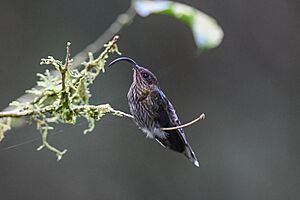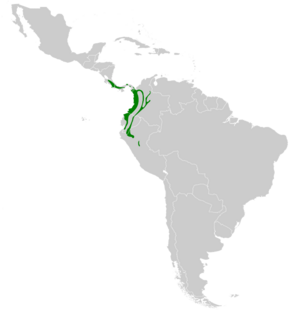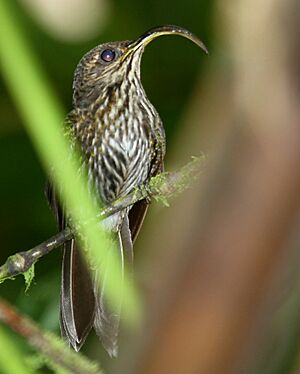White-tipped sicklebill facts for kids
Quick facts for kids White-tipped sicklebill |
|
|---|---|
 |
|
| Conservation status | |
| Scientific classification | |
| Genus: |
Eutoxeres
|
| Species: |
aquila
|
 |
|
The white-tipped sicklebill (scientific name: Eutoxeres aquila) is a very interesting type of hummingbird. It is part of the bird family called Trochilidae. You can find this special bird in several countries. These include Colombia, Costa Rica, Ecuador, Panama, Peru, and Venezuela.
Contents
About the White-tipped Sicklebill
What's in a Name?
The white-tipped sicklebill shares its group, called a genus, with another bird. This bird is the buff-tailed sicklebill (E. condamini). Scientists have also divided the white-tipped sicklebill into three smaller groups. These groups are called subspecies. They are E. a. aquila, E. a. salvini, and E. a. heterurus.
How to Spot It
The most amazing thing about the white-tipped sicklebill is its beak. It curves strongly, almost like a quarter of a circle! The top part of its beak is black. The bottom part is yellow.
This hummingbird is about 11.5 to 13.5 centimeters (4.5 to 5.3 inches) long. It weighs around 8.6 to 14.5 grams (0.3 to 0.5 ounces). Both male and female birds look the same. Their upper bodies are green. Their throat and chest are dark, almost black. The rest of their underside has green and white stripes. Their tail is mostly green. The outer tail feathers are darker with white tips. Young birds look a bit scaly.
Where They Live
Home Sweet Home
The white-tipped sicklebill lives in different places. The northern group, E. a. salvini, lives in Costa Rica, Panama, and western Colombia. Another group, E. a. heterurus, is found from Colombia's Cauca Department south. It also lives through western Ecuador. There's even a record of it in Mérida, western Venezuela. The last group, E. a. aquila, lives from eastern Colombia south. It goes through eastern Ecuador into northern Peru.
These birds like to live in the lower parts of mountain evergreen forests. In Costa Rica, they live at different heights. On the Caribbean side, they are found between 300 and 700 meters (980 and 2,300 feet) high. On the Pacific side, they are found between 1,000 and 1,200 meters (3,300 and 3,900 feet) high. In western Colombia, they live from sea level up to 1,400 meters (4,600 feet). In the Magdalena River valley, they are found between 1,600 and 2,100 meters (5,200 and 6,900 feet). In Peru, they live between 750 and 2,000 meters (2,460 and 6,560 feet).
What They Do
Eating Habits
The white-tipped sicklebill mainly eats nectar from flowers. Its curved beak is perfect for reaching nectar in certain flowers. It especially likes flowers from plants like Centropogon and Heliconia. It usually holds onto the flower while it feeds.
This bird is a "trap-line" feeder. This means it visits a regular path of flowering plants. It does not try to protect any specific area of flowers. Sicklebills also eat insects. They pick insects from spiderwebs or from tree trunks and branches.
Reproduction and Life Cycle
Male white-tipped sicklebills perform a special flight to attract females. They fly in a U-shape in areas called leks. One male bird might mate with several females. This is called being polygynous.
The breeding times for these birds change depending on where they live. It seems they often breed twice a year. The female builds a cup-shaped nest. It hangs from the underside of large Heliconia leaves. Sometimes, they even build nests on human structures. These can be bridges or the ceilings of buildings. The nest is made from rootlets, hair, and plant fibers. It is all held together with spider web. A female usually lays two eggs.
Their Song
The white-tipped sicklebill's song is quite unique. It sounds like a series of thin, whiny squeaks. These are followed by some loud, high tseep notes. Their song can sound a bit different depending on the area. Their call is described as high, thin, sharp, piercing tsitting notes.
Conservation Status
How They Are Doing
The IUCN (International Union for Conservation of Nature) has looked at the white-tipped sicklebill. They have decided it is a species of "Least Concern." This means it is not currently in danger of disappearing. However, scientists don't know exactly how many of these birds there are. They also don't know if their numbers are going up or down.
This bird lives in forests and needs flowers for food. So, if forests get broken up into smaller pieces, it could be a threat to them.



